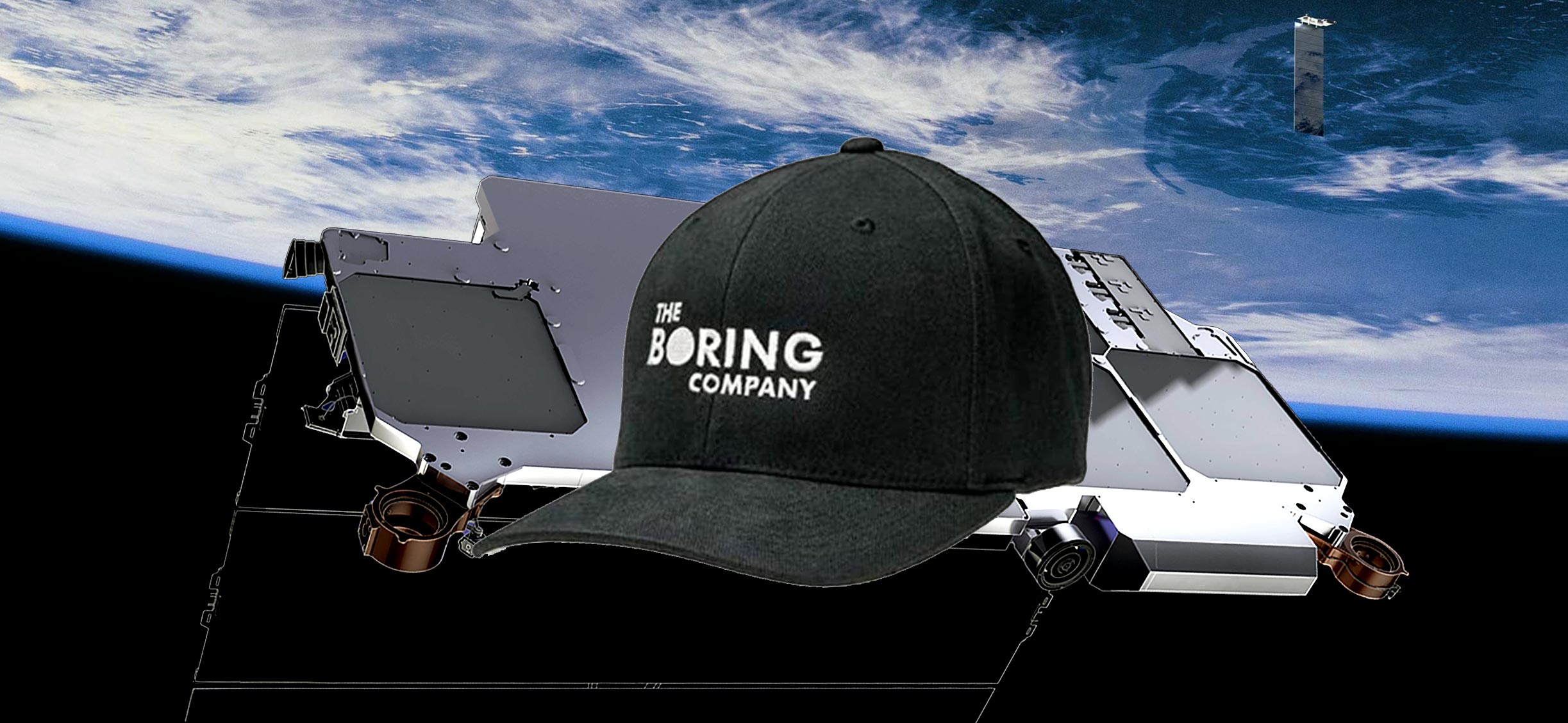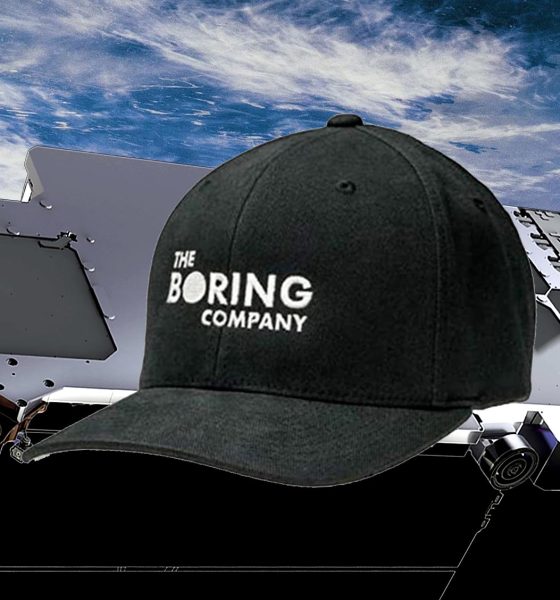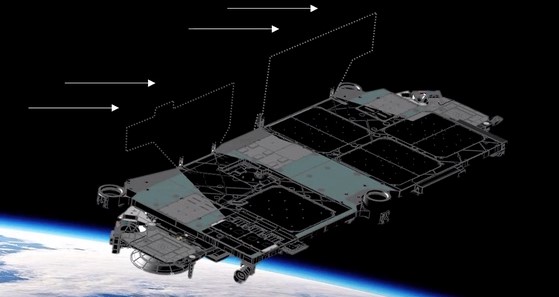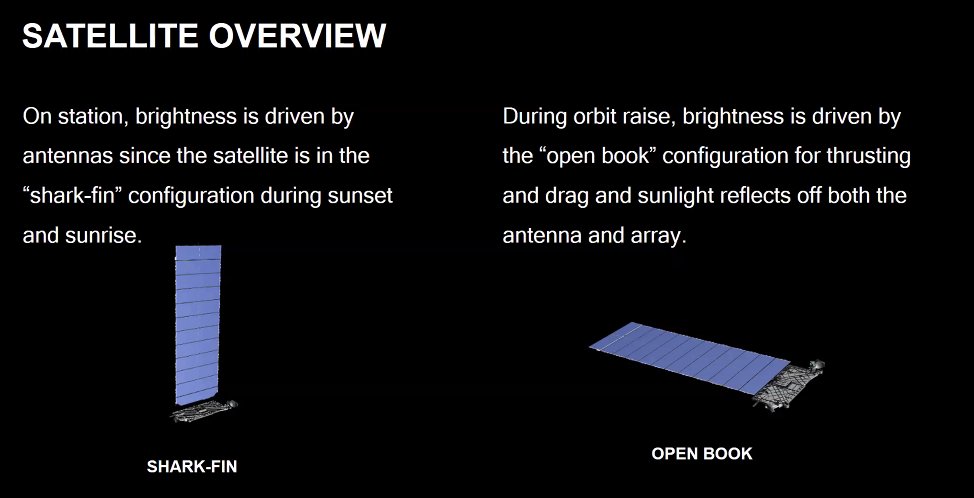

News
SpaceX’s Starlink “VisorSat” launch plans revealed by Elon Musk
CEO Elon Musk has revealed more details about SpaceX’s plans to build and launch upgraded “VisorSat” Starlink satellites, part of the company’s work to ensure that the internet constellation can coexist with astronomy.
Back on April 22nd, Musk gave us the best glimpse yet of what he previously described as a sort of deployable sunshade for Starlink satellites. Designed to prevent orbital sunlight from reflecting off of each spacecraft’s shiny surfaces and disrupting ground-based astronomical observations, the SpaceX CEO said that the company’s very next Starlink launch – scheduled no earlier than “early May” – will carry one or several satellites with said sunshade installed, playfully nicknamed “VisorSat”.
Ultimately, Musk explained in significant detail the likely culprit of the spectacular visibility of Starlink satellites from the ground, discussed plans to reduce or wholly remove that flaring, and explicitly stated that SpaceX will do everything in its power to prevent its constellation from impacting science.
On April 22nd, Musk revealed that the sunshade he’d previously discussed would look “a lot like a car sun visor” and would be built out of dark, radio-transparent foam to avoid disrupting each satellite’s antennas while still preventing sunlight from reflecting off of their mirror-like surfaces.

Days later, he revealed a rough render of VisorSat’s design, showing an extremely simple pair of rotating foam ‘visors’ explicitly shaped to block sunlight from Starlink satellite antennas and not much else. Given the use of foam and a deployment mechanism no more complex than four actuating hinges, it’s entirely believable that this solution – if it works – could be cheap and light enough to be almost irrelevant for the overall spacecraft.
If it works, SpaceX’s ad hoc visor would effectively be the best possible solution for brightness, fully solving the issue while having a near-zero impact on the cost or functionality of each internet satellite. Of course, SpaceX will do what it’s known for and flight-test the new VisorSat design before getting ahead of itself, but if those tests are successful, it would be unsurprising if every future Starlink satellite features a visor.
However, in the process of explaining why Starlink satellites can appear so bright, Musk also hinted at one of the reasons that a visor alone cannot fully solve all of the sources of Starlink’s ground astronomy impact. After launch, Starlink satellites must raise and circularize their orbits to reach an operational altitude, a process that has typically taken 2-4 weeks. During that orbit-raising phase, Musk revealed that Starlink satellites must orient themselves in such a way that the entirety of their front and rear faces – including the solar array – is angled perfectly to reflect sunlight back to Earth.

To alleviate that issue, Musk has said that SpaceX will tweak the orientation and operation of satellites during the orbit raising period, but it’s difficult to see a way to consistently prevent bright reflections without big changes. If SpaceX can’t immediately find a way around that “Open Book” orientation, there will likely be anywhere from 60-180+ Starlink satellites raising their orbits on any given day if the company truly plans to operate a constellation of ~4400 satellites, let alone ~12,000 or ~40,000.
Once orbit-raising is complete, Musk believes that visors will effectively make Starlink satellites invisible to the naked eye, but more work will have to be done if SpaceX wants to fully mitigate Starlink’s astronomy impact.

News
Tesla FSD fleet is nearing 7 billion total miles, including 2.5 billion city miles
As can be seen on Tesla’s official FSD webpage, vehicles equipped with the system have now navigated over 6.99 billion miles.

Tesla’s Full Self-Driving (Supervised) fleet is closing in on almost 7 billion total miles driven, as per data posted by the company on its official FSD webpage.
These figures hint at the massive scale of data fueling Tesla’s rapid FSD improvements, which have been quite notable as of late.
FSD mileage milestones
As can be seen on Tesla’s official FSD webpage, vehicles equipped with the system have now navigated over 6.99 billion miles. Tesla owner and avid FSD tester Whole Mars Catalog also shared a screenshot indicating that from the nearly 7 billion miles traveled by the FSD fleet, more than 2.5 billion miles were driven inside cities.
City miles are particularly valuable for complex urban scenarios like unprotected turns, pedestrian interactions, and traffic lights. This is also the difference-maker for FSD, as only complex solutions, such as Waymo’s self-driving taxis, operate similarly on inner-city streets. And even then, incidents such as the San Francisco blackouts have proven challenging for sensor-rich vehicles like Waymos.
Tesla’s data edge
Tesla has a number of advantages in the autonomous vehicle sector, one of which is the size of its fleet and the number of vehicles training FSD on real-world roads. Tesla’s nearly 7 billion FSD miles then allow the company to roll out updates that make its vehicles behave like they are being driven by experienced drivers, even if they are operating on their own.
So notable are Tesla’s improvements to FSD that NVIDIA Director of Robotics Jim Fan, after experiencing FSD v14, noted that the system is the first AI that passes what he described as a “Physical Turing Test.”
“Despite knowing exactly how robot learning works, I still find it magical watching the steering wheel turn by itself. First it feels surreal, next it becomes routine. Then, like the smartphone, taking it away actively hurts. This is how humanity gets rewired and glued to god-like technologies,” Fan wrote in a post on X.
News
Tesla starts showing how FSD will change lives in Europe
Local officials tested the system on narrow country roads and were impressed by FSD’s smooth, human-like driving, with some calling the service a game-changer for everyday life in areas that are far from urban centers.

Tesla has launched Europe’s first public shuttle service using Full Self-Driving (Supervised) in the rural Eifelkreis Bitburg-Prüm region of Germany, demonstrating how the technology can restore independence and mobility for people who struggle with limited transport options.
Local officials tested the system on narrow country roads and were impressed by FSD’s smooth, human-like driving, with some calling the service a game-changer for everyday life in areas that are far from urban centers.
Officials see real impact on rural residents
Arzfeld Mayor Johannes Kuhl and District Administrator Andreas Kruppert personally tested the Tesla shuttle service. This allowed them to see just how well FSD navigated winding lanes and rural roads confidently. Kruppert said, “Autonomous driving sounds like science fiction to many, but we simply see here that it works totally well in rural regions too.” Kuhl, for his part, also noted that FSD “feels like a very experienced driver.”
The pilot complements the area’s “Citizen Bus” program, which provides on-demand rides for elderly residents who can no longer drive themselves. Tesla Europe shared a video of a demonstration of the service, highlighting how FSD gives people their freedom back, even in places where public transport is not as prevalent.
What the Ministry for Economic Affairs and Transport says
Rhineland-Palatinate’s Minister Daniela Schmitt supported the project, praising the collaboration that made this “first of its kind in Europe” possible. As per the ministry, the rural rollout for the service shows FSD’s potential beyond major cities, and it delivers tangible benefits like grocery runs, doctor visits, and social connections for isolated residents.
“Reliable and flexible mobility is especially vital in rural areas. With the launch of a shuttle service using self-driving vehicles (FSD supervised) by Tesla in the Eifelkreis Bitburg-Prüm, an innovative pilot project is now getting underway that complements local community bus services. It is the first project of its kind in Europe.
“The result is a real gain for rural mobility: greater accessibility, more flexibility and tangible benefits for everyday life. A strong signal for innovation, cooperation and future-oriented mobility beyond urban centers,” the ministry wrote in a LinkedIn post.
News
Tesla China quietly posts Robotaxi-related job listing
Tesla China is currently seeking a Low Voltage Electrical Engineer to work on circuit board design for the company’s autonomous vehicles.

Tesla has posted a new job listing in Shanghai explicitly tied to its Robotaxi program, fueling speculation that the company is preparing to launch its dedicated autonomous ride-hailing service in China.
As noted in the listing, Tesla China is currently seeking a Low Voltage Electrical Engineer to work on circuit board design for the company’s autonomous vehicles.
Robotaxi-specific role
The listing, which was shared on social media platform X by industry watcher @tslaming, suggested that Tesla China is looking to fill the role urgently. The job listing itself specifically mentions that the person hired for the role will be working on the Low Voltage Hardware team, which would design the circuit boards that would serve as the nervous system of the Robotaxi.
Key tasks for the role, as indicated in the job listing, include collaboration with PCB layout, firmware, mechanical, program management, and validation teams, among other responsibilities. The role is based in Shanghai.
China Robotaxi launch
China represents a massive potential market for robotaxis, with its dense urban centers and supportive policies in select cities. Tesla has limited permission to roll out FSD in the country, though despite this, its vehicles have been hailed as among the best in the market when it comes to autonomous features. So far, at least, it appears that China supports Tesla’s FSD and Robotaxi rollout.
This was hinted at in November, when Tesla brought the Cybercab to the 8th China International Import Expo (CIIE) in Shanghai, marking the first time that the autonomous two-seater was brought to the Asia-Pacific region. The vehicle, despite not having a release date in China, received a significant amount of interest among the event’s attendees.








